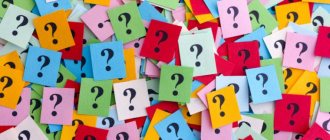attracting sales clients
17.03.2021
Author: Academy-of-capital.ru
Add a comment
Rating:
| (Votes: 1, Rating: 5) |
From this material you will learn:
- The purpose of clarifying the client's needs
- 5 types of questions when communicating with a potential buyer
- The essence of open questions
- Pros and cons of open questions
- 4 types of open questions to identify client needs
- Examples of open-ended questions for various situations
- 3 Helpful Tips for Using Open Questions
Although open questions to clarify the client’s needs are quite simple when using one or another sales technique, you still need to be able to handle them correctly. And this matter is not as simple as it may naively seem to inexperienced managers.
It’s not enough to simply ask an open-ended question and then listen carefully to what the potential buyer has to say. It is important to ensure that the person provides very specific information, and not just pour out his soul to a grateful listener. That is, you need to clearly understand what exactly to ask and at what point it is better to do it.
What questions exist in Russian?
In this work we will look at 5 types of questions. There are a number of other classifications, the number of questions in which may vary, but today we will focus on this one.
So, according to our classification, there are five types of questions: closed, open, turning points, rhetorical, questions for reflection. Note that open and closed questions are distinguished in almost all types of classifications. This fact makes them basic.
Now let's look at each type in more detail, and also give examples.
Technique of asking questions
There is a principle in computer science that says, “Garbage in, garbage out.” It means that if the input data is incorrect, incorrect results will be obtained, even if the algorithm itself is correct. The same principle can be applied in communication: the wrong questions give the wrong answers. Asking the right question is an art and can greatly increase your understanding of a topic or improve your relationships with others. The main function of good questioning is to collect the necessary information, learn something, and draw the right logical conclusion.
Let's look at several questioning techniques and in what situations you should use them.
1
Open and closed questions
A closed question requires a short, clear and understandable answer. It is not able to make the interlocutor talk, because it looks more like a question from an interview or an interview. For example, “Are you hungry?” or “Where do you live?” suggest a simple answer. However, if your interlocutor answered a closed question with a story and emotions, it means he is interested in further communication and this is a good sign.
Open questions are aimed at obtaining detailed answers. They usually begin with the words “what,” “why,” “why,” and “how.” An open question aims to find out the interlocutor's point of view and evoke emotions in him. Questions of this type also include phrases like: “Tell me...”, “Describe it to me...”. Here are examples of open questions:
- What happened at the meeting?
- Why did you react this way?
- How was the party?
- Tell me what happened then.
- Describe everything to me in detail.
Open questions are good for:
- The beginning of a frank conversation.
- Clarification of details.
- Finding out the causes of the problem or the opinion of the interlocutor.
Closed questions are good for:
- Testing the understanding of what the person wanted to say: “So, if I improve my qualifications, I will get a raise?”
- Decision Making: “Now that we have all the facts, does everyone agree that we have chosen the right course of action?”
- Understanding: “Are you satisfied with our service?”
If you want to get someone to talk and only use closed questions, this will lead to awkward pauses and can destroy any positive intentions.
2
Funnel Questions
This technique is quite simple and effective: you start with general questions, and then with each subsequent question you narrow the topic and move to a new level of detail. This method is often used by detectives when questioning a witness:
- How many people were involved in the fight?
- About ten.
- Were they children or adults?
- Mostly children.
- How old are they approximately?
- From fourteen to sixteen.
- Were they dressed in any special way?
- Yes, some of them were wearing red baseball caps.
- Can you remember what logo was on the baseball caps?
- Yes, I seem to remember a capital N.
You can combine this technique with closed and open questions. Start with closed questions and the big picture, and when it comes to details, add open questions and start evoking emotions.
3
Clarifying questions
This is another way to get parts. Sometimes it is enough to ask the interlocutor to give an example to understand what he wanted to say with his statement. Or you may need more information to understand: “When do you need my report and do you want to see a rough draft before the final version?” You can also ask for evidence: “On what basis do you think that the new product will not be in demand? More?".
When using this technique, use the word “exactly” more often: “What exactly do you want to say?”
Follow-up questions are good for:
- Get clarification to understand the big picture.
- Extracting information from a person who is avoiding telling a story.
You can also use the “Why?” method. for personal effectiveness.
4
Suggestive questions
Leading questions try to bring the other person's point of view to yours. They can be set in several ways:
- With the assumption: “How late do you think we will deliver this project?” This question assumes that the project will definitely not be delivered on time.
- With the addition of a personal appeal or agreement: “It works very effectively, doesn’t it?” or “The second option is better, right?”
- Formulate the question in such a way that it is easier for the interlocutor to say “yes.” The question “Should we approve the second option?” is more likely to receive a positive response than: “Do you want to approve the second option?”
- Giving a person a choice between two options that are acceptable to you is better than giving a choice between the action you want and no action.
Leading questions are good in the following cases:
- Let the person choose between the options you want, leaving them feeling like they had a choice. This method is a manipulation and should be used only if you want to do what is best.
- When closing a sale or transaction: “If those are all your questions, let’s move on to discussing price?”
By the way, please note that leading questions are mostly closed-ended.
5
Rhetorical questions
Rhetorical questions by their nature do not require an answer. In fact, these are statements expressed in the interrogative form: “Isn’t this movie great?” People use rhetorical questions to engage the listener and also to get them to agree with them.
They are also great when they go one after another: “Isn’t this monitor good? Wouldn’t you love watching movies on it and enjoying the picture quality?”
Using Questioning Techniques
You've probably already used all of these techniques in different areas of your life, but using them consciously can help you achieve much greater goals.
Questions are good for the following areas of life:
- Training : Ask open-ended, closed-ended, and follow-up questions frequently.
- Relationships : People generally respond positively when asked to speak their mind or tell them what they are doing. A simple question: “What do you think about this?” able to make almost anyone talk.
- Leadership : Rhetorical and leading questions are appropriate in managing people.
- Avoiding misunderstandings : Use follow-up questions to clarify the situation. Also read the article “Ladder of Inference”, which will help you not make hasty decisions.
- Defusing the situation : funnel-shaped questions help to find out the cause of dissatisfaction and remove a person’s negative emotions.
- Persuading People : No one likes to be lectured, so open-ended questions will help you find out the other person's point of view and convince them of something.
Remember to give the person time to answer your question. Don't infer a pause as a sign of disagreement.
Develop your listening skill because this is what will allow you to master the art of asking the right questions. Also be aware of your body language, which also matters to your interlocutor.
We also recommend our literacy course, which will identify your typical mistakes and give you special exercises to correct them.
We wish you good luck!
We also recommend reading:
- Storytelling
- The power of questions
- Conversation Techniques
- Questions before, during and after reading a fiction book
- Best Interview Questions
- How to answer awkward questions?
- Why ask questions?
- Black rhetoric. Part nine. About the types of questions
- Wait, what did you say?
- Identifying Cheating with Six Questions
- Questions to get to know a person better
Key words:1Communication
Open question
Open questions are questions that require a detailed answer and some explanation. It is impossible to answer them either “yes” or “no”. Such questions begin with the following interrogative words: “how”, “who”, “what”, “why”, “how much”, “which”, etc.
Such questions allow your interlocutor to choose the information to answer at his own discretion. On the one hand, this can lead to the interlocutor hiding something that he does not want to disclose. But on the other hand, if in a suitable emotional situation, the interlocutor can open up and tell much more than the question you asked required.
Open-ended questions allow you to turn your monologue into a conversation. However, there is a danger that you will lose control of the conversation and it will be difficult to regain control.
Here are examples of such questions:
- Why do you want to study at our university?
- When did you decide to agree to this conversation?
- How much do you earn per month?
- Who cleans your home?
- What do you usually do in the evenings?
Communicative communication involves the ability to correctly pose questions
Questions are a way to get the information you need and to direct the conversation in the right direction.
Questions enable us to discover what interests us most. A well-posed question, in addition to providing you with the required information, will allow you to avoid conflict situations and missteps.
It doesn’t matter who you are: a manager, a basketball coach, a psychologist, you will definitely need the ability to correctly pose a question.
The right questions allow you to:
- Show interest in your opponent;
- Demonstrate your value system, which will be understandable to the interlocutor, and learn about his values;
- Get the necessary information, show that you can devote sufficient time to talk;
- Take the initiative and control the flow of the conversation;
- Change the topic of conversation;
If you want to hear a smart answer, ask smartly
Closed question
Closed-type questions are those that can be answered either “yes” or “no.” The particle “whether” is often used in closed questions. They limit the freedom of the interlocutor as much as possible, leading him to a monosyllabic answer.
By asking these kinds of questions, you can keep the conversation under control. However, the interlocutor cannot express his opinion or share ideas.
In addition, closed questions have a number of negative features:
- the information obtained when answering them will be superficial;
- two answer options create the impression of coercion, so the interlocutor will gradually feel more and more uncomfortable, which will ultimately lead to the fact that he will want to end the conversation as soon as possible;
- they lead to the interlocutor’s reluctance to open up and provide more information.
Closed questions are recommended for use in cases where it is necessary to collect a lot of information in a short period of time. For example, when conducting various studies. If you plan to get to know your interlocutor better and expect that your acquaintance will continue, you should definitely alternate closed questions with open ones, allowing your partner to speak out.
Examples:
- Do you like running?
- Would you like to learn to swim?
- Do you play musical instruments?
How to win over your opponent?
As you know, brevity is the sister of talent .
The question should be short, concise and clear. A complex and lengthy question may confuse your interlocutor, so you will not receive a specific answer. To prevent the interlocutor from feeling that he is under interrogation, use soft intonations. When asking a question, do it in a relaxed manner.
“For the answer to be positive, the question must be seductive.” Stas Yankovsky
A rhetorical question
Let's continue to look at question types. Next in line is a rhetorical question, which serves for a deep and detailed consideration of the subject of conversation. It is impossible to give an unambiguous and unbiased answer to such questions. Their purpose is to highlight unresolved issues and raise new questions, or to elicit support from the panelists for your opinion through tacit agreement. When composing such questions, the particle “whether” is also often used.
Examples:
- We all share the same opinion on this issue, right?
- Can we accept such actions as normal?
The turning point question
Another basic type of question is the turning point. These are the kinds of questions that help keep the discussion moving in a certain direction. They can also serve to raise new issues. They are asked in situations when you have received comprehensive information on the problem under consideration and would like to switch the audience’s attention to another, or when resistance from your opponent has arisen and you want to overcome it.
The interlocutor’s answers to such questions make it possible to clarify vulnerable points in his judgments.
Examples:
- Tell me, do you think it is necessary?..
- How is it really going for you?..
- What do you think?..
- What do you see in the future?..
Question to think about
These types of questions encourage the interlocutor to reflect and carefully consider what was said earlier and prepare comments. In such a speech situation, the interlocutor gets the opportunity to make his own changes to the position already stated by someone. This allows you to look at the problem from several sides.
Examples of such questions:
- Do you think that...?
- Did we understand your judgment correctly that...?
- Do you agree that...?
Thus, we have looked at the meaning and examples of the types of questions used in Russian.
How to ask questions correctly
To pose the question correctly, you must first competently build an internal dialogue and formulate your thoughts. The quality and relevance of our questions in most cases influences the actions we take.
Two options for questions have been identified:
- 7 traditional questions: What?
Where? How? Who? Why? By what means? These questions provide an opportunity to analyze the situation as a whole; - 6 questions involving feelings, facts, desires, time, means, obstacles.
When asking a question to our interlocutor, we are guided by the goal of establishing a positive relationship with him.
However, you can achieve this without making it seem like an interrogation. Speech as a means of communication
General question
General questions are identical to closed questions in Russian, that is, they require a monosyllabic answer: “yes” or “no.” Serve to obtain general information only.
Such questions are composed without question words, but begin with auxiliary verbs. And as you remember, in English there are certain auxiliary verbs for each tense.
The word order when composing a question is: auxiliary verb - subject - semantic verb - object - definition.
Examples:
- Is he a good driver?
- Did he go to the disco today?
- Do you play basketball every day?
Provocative questions
As you get to know each other, your conversation will inevitably lead to a few burning questions.
While you're expected to give witty and playful answers, you need to make sure you're also prepared to ask downright awkward questions!
Remember, two can play this game!
- What attracts you most about the opposite sex?
- Do you like fragile girls/brutal guys?
- How homely are you?
- Do you like aggressive sex?
- At what age did you lose your virginity?
- What is your favorite position?
- Burn or go out?
- In what unusual place have you had the craziest sex?
- Have you ever kissed a boyfriend/girlfriend before?
- What's your favorite porn category?
- What's better? Big butt or big breasts?
- Worst one night experience?
- Have you ever been offered a threesome?
- Have you ever sent explicit photos of yourself to your significant other?
- What is your biggest sexual disappointment?
- Do you like to be offended by women/men?
- Do you have any sexual fantasies with someone with whom this would never happen?
- Do you like younger or older women/men?
- Do you like seeing your girlfriend/boyfriend in underwear?
- When is the best time to have sex?
- Do you like car sex?
- What is the dirtiest and most vulgar thing you have done in public?
- How long have you been out of a relationship?
- Have you ever been intimate with someone of a different race?
- What's your most embarrassing sexual experience?
Separated question
We continue to look at the types of questions in English with examples. This type is called separative because it consists of two parts, which are separated by a comma:
- Part 1 is a statement;
- Part 2 – “spine”, a question regarding this statement.
"Spine" is usually the opposite of the statement. That is, the purpose of the question is to verify the authenticity of the statement made.
Examples:
- You play basketball every day, don't you?
- Steven is a famous artist, isn't he?
Special question
Question types can also be used to obtain additional information. For example, a special question. It always starts with question words. The following are usually used: when, why, where, which, how, etc. These words do not include what and who when they act as subjects.
Thus, the question has the following structure: question word - auxiliary verb - subject - semantic verb - object.
Examples:
- What is your name?
- When did you go to England last time?
Questions with or (“or”)
Such questions require a choice between two different answer options. The word order here is the same as in the general question, but it is necessary to offer an alternative possibility.
Examples:
- Do you like tea or coffee?
- Will you go to Moscow by plane or by train?
- Does your father or your mother help you with your homework?
Question with who (what)
This type is used when it is necessary to the subject of a sentence. It will begin with the words what or who. The main feature of this type of question is that the word order when composing it remains the same as in the statement. That is, the word order will be as follows: who/what – semantic verb – object.
Here are some examples:
- Who is this man?
- What was that?
So, we looked at the possible types of questions in both Russian and English. As you can see, in both languages, despite the huge difference in origin and grammar between them, questions perform approximately the same functions. This tells us that conversations in any language are conducted for specific purposes. Moreover, the reasoning control mechanisms regulated by questions also appear to be similar.
The purpose of clarifying the client's needs
The main task in the work of managers and marketers is to identify the needs and problems of the client and offer solutions to them. If you simply list the good qualities of a product, a person will not have the desire to buy. It is necessary to indicate those characteristics of the product that will solve the problem of a particular buyer. The manager must understand what worries the client.
Here's an example. A person comes to a bicycle store because he wants to remember his childhood and how he rode like a breeze. An unprofessional seller will talk about the advantages of the equipment, eight speeds, shock absorbers and braking system. An experienced manager first finds out why the client wants to buy a bike. And then, based on the information received, he will offer a suitable option.
With the knowledge of how to identify customer needs, you can accurately identify the true problems and present the product as a solution. By using open-ended questions to identify buyer needs, you will save your time and perform your product sales duties efficiently.
After your presentation of the advantages of the product, the buyer may have objections, which you will confidently resolve. In fact, a person’s fears are not based on the quality of the product; he simply does not feel confident that your product will meet his needs. Knowing this, the manager will be able to choose the right wording to respond to the objection.
If the client is not sure of his choice, the seller can confirm his purchase. Just support him with a kind word, show that you understand his feelings. Such actions will confirm the person’s choice, and he will be satisfied with the purchase.
There are two effective ways to determine customer needs. In the first case, you need to listen carefully to the buyer, perhaps his problems will become clear to you. But sometimes a person finds it difficult to say what he wants. Then you can use the second method - questions. You just need to ask tactfully and politely so that the client does not feel like he is being interrogated.










